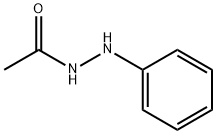114-83-0

Product Name:
1-Acetyl-2-phenylhydrazine
Formula:
C8H10N2O
Synonyms:
2-Phenylacetohydrazide;Acetic acid 2-phenylhydrazide, 1-Acetyl-2-phenylhydrazine
Inquiry
CHEMICAL AND PHYSICAL PROPERTIES
| Physical Description | 1-acetyl-2-phenylhydrazide appears as colorless prisms or white solid. (NTP, 1992) |
|---|---|
| Color/Form | Hexagonal prisms |
| Melting Point | 264 to 270 °F (NTP, 1992) |
| Solubility | less than 1 mg/mL at 66 °F (NTP, 1992) |
| Vapor Pressure | 0.000073 [mmHg] |
| LogP | log Kow = 0.74 /Estimated/ |
| Henry's Law Constant | Henry's Law constant = 2.6X10-11 atm-cu m/mol at 25 °C /Estimated/ |
| Decomposition | When heated to decomposition it emits toxic fumes of /nitrogen oxide/ |
| Kovats Retention Index | 1906 |
| Other Experimental Properties | Hydroxyl radical reaction rate constant = 4.8X10-11 cu cm/molec-sec at 25 °C /Estimated/ |
| Chemical Classes | Nitrogen Compounds -> Hydrazides |
SAFETY INFORMATION
| Signal word | Danger |
|---|---|
| Pictogram(s) |
 Skull and Crossbones Acute Toxicity GHS06 |
| GHS Hazard Statements |
H301:Acute toxicity,oral |
| Precautionary Statement Codes |
P264:Wash hands thoroughly after handling. P264:Wash skin thouroughly after handling. P270:Do not eat, drink or smoke when using this product. P301+P310:IF SWALLOWED: Immediately call a POISON CENTER or doctor/physician. P405:Store locked up. P501:Dispose of contents/container to..… |
COMPUTED DESCRIPTORS
| Molecular Weight | 150.18 g/mol |
|---|---|
| XLogP3 | 0.7 |
| Hydrogen Bond Donor Count | 2 |
| Hydrogen Bond Acceptor Count | 2 |
| Rotatable Bond Count | 2 |
| Exact Mass | 150.079312947 g/mol |
| Monoisotopic Mass | 150.079312947 g/mol |
| Topological Polar Surface Area | 41.1 Ų |
| Heavy Atom Count | 11 |
| Formal Charge | 0 |
| Complexity | 130 |
| Isotope Atom Count | 0 |
| Defined Atom Stereocenter Count | 0 |
| Undefined Atom Stereocenter Count | 0 |
| Defined Bond Stereocenter Count | 0 |
| Undefined Bond Stereocenter Count | 0 |
| Covalently-Bonded Unit Count | 1 |
| Compound Is Canonicalized | Yes |
PRODUCT INTRODUCTION
description
1-acetyl-2-phenylhydrazide appears as colorless prisms or white solid. (NTP, 1992)
